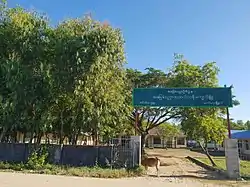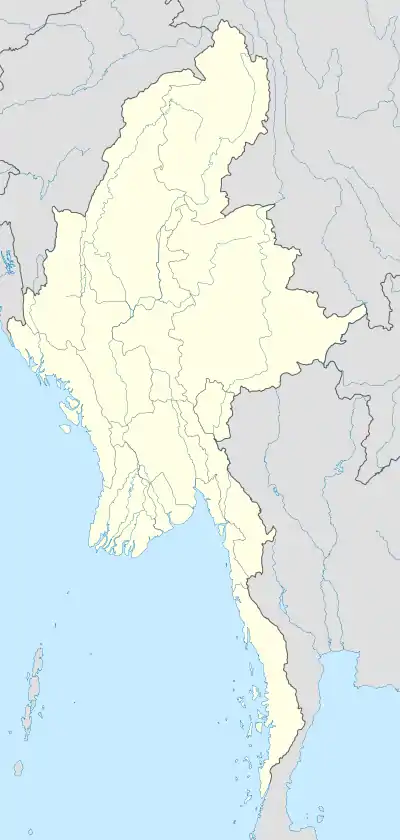Inn Din | |
|---|---|
Village | |
 A school in Inn Din | |
 Inn Din Location in Myanmar (Burma) | |
| Coordinates: 20°30′46″N 92°34′48″E / 20.51278°N 92.58000°E | |
| Country | |
| Division | Rakhine State |
| District | Maungdaw District |
| Township | Maungdaw Township |
| Population (October 2017) | 6,000+[1] |
| Time zone | UTC+6.30 (MMT) |
Inn Din is a village in northern Rakhine State, Myanmar.[2][3] The village is in an area of mixed ethnicity, including Rohingya and ethnic Rakhine people.[4] In December 2017, a mass grave with ten Rohingya men was discovered near the Inn Din cemetery. In January 2018, the Myanmar military admitted that its soldiers and Rakhine paramilitaries had killed the ten Rohingyas in September of the previous year.[5]
Geography

The village is in the south of Rakhine State, located on the coast of the Bay of Bengal, at the western margin of Myanmar. Inn Din is near Maungdaw, just west of Rathedaung, and north of Sittwe.[2][6] It rests on a peninsula that is a part of the Mayu and Kaladan (Kitsapanadi) river deltas.[7]
Economy
Some sources of income for Inn Din residents include betel tree and rice farming and fishing.[8] Residents have opposed construction of a coal-fired power plant in the area, developed by a Thai affiliate company for the Toyo Engineering Corporation.[8]
2017 massacre
In December 2017, the Myanmar military declared that it would investigate a grave containing unidentified bodies.[6] The army announced the investigation in a Facebook post by Senior General Min Aung Hlaing.[9]
On 10 January 2018, newspapers reported that Myanmar's military had admitted to killing Rohingya Muslims near the village on 2 September 2017.[6] The military released the findings of its investigation in a second Facebook post, and stated that they had decided to kill Rohingya whom they had detained in the Inn Din cemetery.[5] The Rohingya were subsequently buried in a mass grave at Inn Din.[2] The military stated that its soldiers had helped villagers carry out a revenge attack on people they described as "Bengali terrorists".[6]
Two Reuters journalists investigating evidence of the mass grave at the village were arrested in Yangon and sentenced to seven years in prison. An adviser for Amnesty International stated that satellite photos showed that Rohingya homes around Inn Din had been burned down in a coordinated fashion.[2]
See also
References
- ↑ Lone, Wa; Oo, Kyaw Soe; Lewis, Simon; Slodkowski, Antoni. "Massacre in Myanmar: One grave for 10 Rohingya men". Reuters. Retrieved 10 February 2018.
- 1 2 3 4 Taylor, Adam (10 January 2018). "In a first, Burmese military admits that soldiers killed Rohingya found in mass grave". The Washington Post. Retrieved 10 January 2018.
- ↑ "Myanmar military: Soldiers murdered 10 captured Rohingya 'terrorists' after Buddhists forced them into grave". The Japan Times. Reuters. 11 January 2018. Retrieved 10 January 2018.
The military announced on Dec. 18 that a mass grave containing 10 bodies had been found at the coastal village of Inn Din, about 50 km (30 miles) north of the state capital Sittwe. The army appointed a senior officer to investigate.
- ↑ Kipgen, Nehginpao (11 January 2018). "A difficult year for Myanmar". The Hindu. Retrieved 11 January 2018.
- 1 2 "Myanmar security forces took part in killing 10 Rohingya: Army". Straits Times. AFP. 10 January 2018. Retrieved 10 January 2018.
- 1 2 3 4 "Rohingya crisis: Myanmar army admits killings". BBC. 10 January 2018. Retrieved 10 January 2018.
- ↑ "Arakan Research Center". Trek Thailand. Retrieved 10 January 2018.
- 1 2 Khai, Khen Suan (2015). "Japan's Official Development Assistance Diplomacy towards Burma in Post 2012" (PDF). International Conference on Burma/Myanmar Studies. University Academic Service Centre (UNISERV), Chiang Mai University: 10. Retrieved 10 January 2018.
- ↑ "A Mass Grave Has Been Found in Western Myanmar, the Military Says". Time. Reuters. 19 December 2017. Retrieved 10 January 2018.